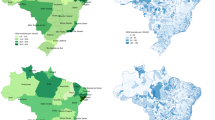Abstract
The war against drugs started in Mexico in 2007. During the following years, there was an unprecedented increase in violence and homicides across the country. It is important to find vulnerable groups of population and to quantify effects of demographic covariates, and spatial and time dependence. We present a Bayesian Poisson regression model of the number of homicides with four factors: sex, age, year, state of occurrence, and two-way interactions of these variables. For the main effects of sex and age, we define independent prior distributions, a dynamic linear prior for temporal effects, and conditionally autoregressive processes for spatial effects and spatial interactions. Identification of vulnerable groups by regions provides a tool to design prevention policies targeted at local levels.
Access this chapter
Tax calculation will be finalised at checkout
Purchases are for personal use only
Similar content being viewed by others
References
Astorga, L.: Qué querían que hiciera? Inseguridad y delincuencia organizada en el gobierno de Felipe Calderón, 1st edn. Penguin Random House Grupo Editorial (2015)
Atuesta, L.H., Ponce, A.F.: Meet the Narco: increased competition among criminal organisations and the explosion of violence in Mexico. Glob. Crime 18(4), 375–402 (2017). https://doi.org/10.1080/17440572.2017.1354520
Castillo, J.C., Mejia, D., Restrepo, P.: Scarcity without Leviathan: the violent effects of cocaine supply shortages in the Mexican drug war. Rev. Econ. Stat. 102(2), 269–286 (2020). https://doi.org/10.1162/rest_a_00801
Celis, M.d.P.: Geografía de la violencia en México. un acercamiento a la reconfiguración territorial de la violencia generada por el crimen organizado (2016). https://politicadedrogas.org/documentos/20161106_164436_15_geografaaviolenciafinal_281016.pdf
Cressie, N.A.: Statistics for Spatial Data, revised Wiley, New York (1993)
Curiel, R.P., Delmar, S.C., Bishop, S.R.: Measuring the distribution of crime and its concentration. J. Quant. Criminol. 34, 775–803 (2018). https://doi.org/10.1007/s10940-017-9354-9
Damián Bernal, A.L.: La manifestación espacial de la violencia feminicida en México, 2000–2006. Master thesis, UNAM, Facultad de Filosofía y Letras (2010)
Dell, M.: Trafficking network and the Mexican drug war. Am. Econ. Rev. 105(6), 1738–79 (2015). https://doi.org/10.1257/aer.20121637
Durán-Martínez, A.: To kill and tell? State power, criminal competition and drug violence. J. Conflict. Resolut. 1–27 (2015). https://doi.org/10.1177/0022002715587047
Espinal-Enriquez, J., Larralde, H.: Analysis of Mexico’s Narco-war network (2007–2011). PLoS ONE 10(5), 1–15 (2015). https://doi.org/10.1371/journal.pone.0126503
Flores, M., Rodríguez-Oreggia, E.: Spillover effect on homicides across Mexican municipalities: a spatial regime model approach. Rev. Reg. Stud. 44(3), 241–262 (2014). https://doi.org/10.52324/001c.8072
Fuerte-Celis, P., Sanchez-Castañeda, D.: Clusters of violence in Mexico: an analysis of homicide rates from 2000 to 2012. J. Lat. Am. Geogr. (2021). https://doi.org/10.1353/lag.2021.0004
García-Ponce, O., Dube, A., Dube, O.: Cross-border spillover: U.S. gun laws and violence in Mexico. Am. Polit. Sci. Rev. 107(3), 397–417 (2013). https://doi.org/10.1017/S0003055413000178
Guerrero-Gutierrez, E.: Security, drugs, and violence in Mexico: a survey. In: 7th North American Forum. Washington, US (2011). https://lantiaintelligence.com/storage/document/15/NAF_2011.pdf
Ibrahim, J., Laud, P.: A predictive approach to the analysis of designed experiments. J. Am. Stat. Assoc. 89(425), 309–319 (1994)
Ingram, M.C., Marchesini da Costa, M.: A spatial analysis of homicide across Brazil’s municipalities. Homicide Stud. 21(2), 87–110 (2017). https://doi.org/10.1177/1088767916666603
Lacombe, D.J., Flores, M.: A hierarchical SLX model application to violent crime in Mexico. Ann. Reg. Sci. 58, 119–134 (2017). https://doi.org/10.1007/s00168-016-0788-z
Lawson, A.B.: Bayesian Disease Map**: Hierarchical Modeling in Spatial Epidemiology. Chapman and Hall, CRC (2013). https://doi.org/10.1201/9781351271769
Leenen, I., Cervantes-Trejo, A.: Temporal and geographic trends in homicide and suicide rates in Mexico, from 1998 through 2012. Aggress. Violent Behav. 19, 699–707 (2014). https://doi.org/10.1016/j.avb.2014.09.004
Liu, Y., Fullerton, T.M., Ashby, N.J.: Assessing the impacts of labor market and deterrence variables on crime rates in Mexico. Contemp. Econ. Policy 31(4), 669–90 (2013). https://doi.org/10.1111/j.1465-7287.2012.00339.x
Lunn, D., Spiegelhalter, D., Thomas, A., Best, N.: The bugs project: evolution, critique and future directions (with discussion). Stat. Med. 28, 3049–3082 (2009)
Márquez-Padilla, F., Pérez-Arce, F., Rodríguez-Castelán, C.: The (non-) effect of violence on education: evidence from the ‘war on drugs’ in Mexico (2015). https://doi.org/10.2139/ssrn.2793566
Montgomery, D.C.: Design and Analysis of Experiments, 4th edn. Wiley (1997)
Osorio, J.: The contagion of drug violence: spatiotemporal dynamics of the Mexican war on drugs. J. Conflict Resolut. 59(8), 1403–32 (2014). https://doi.org/10.1177/0022002715587048
Pan, M., Widner, B., Enomoto, C.E.: Growth and crime in contiguous State of Mexico. Rev. Urban Reg. Dev. Stud. 24(1–2), 21–64 (2012). https://doi.org/10.1111/j.1467-940X.2012.00188.x
Parker, R.N.: Poverty, subculture of violence, and type of homicide. Soc. Forces 67(4), 983–1007 (1989). https://doi.org/10.1093/sf/67.4.983
Ríos Contreras, V.: How government structure encourages criminal violence: the causes of Mexico’s drug war. Ph.D. thesis, Harvard University (2013). https://dash.harvard.edu/bitstream/handle/1/11156675/RiosContreras_gsas.harvard_0084L_10752.pdf?sequence=3&isAllowed=y
Snyder, R., Durán-Martínez, A.: Does illegality breed violence? Drug trafficking and state-sponsored protection rackets. Crime, Law Soc. Chang. 52(3), 253–73 (2009). https://doi.org/10.1007/s10611-009-9195-z
Sturtz, S., Ligess, U., Gelman, A.: R2OpenBUGS a package for running OpenBUGS from R. J. Stat. Softw. 12(3), 1–16 (2005). https://cran.r-project.org/web/packages/R2OpenBUGS/vignettes/R2OpenBUGS.pdf
Valdés, C.G.: Historia del narcotráfico en México, 3a. edn. Ed. Aguilar (2013)
Author information
Authors and Affiliations
Corresponding author
Editor information
Editors and Affiliations
Rights and permissions
Copyright information
© 2022 The Author(s), under exclusive license to Springer Nature Switzerland AG
About this paper
Cite this paper
Sánchez-Castañeda, M.d.l.D., Nieto-Barajas, L.E., Fuerte Celis, M.d.P. (2022). Bayesian Analysis of Homicide Rates in Mexico from 2000 to 2012. In: Antoniano-Villalobos, I., Fuentes-García, R., Naranjo, L., Nieto-Barajas, L.E., Ruiz-Velasco Acosta, S. (eds) Interdisciplinary Statistics in Mexico. Springer Proceedings in Mathematics & Statistics, vol 397. Springer, Cham. https://doi.org/10.1007/978-3-031-12778-6_13
Download citation
DOI: https://doi.org/10.1007/978-3-031-12778-6_13
Published:
Publisher Name: Springer, Cham
Print ISBN: 978-3-031-12777-9
Online ISBN: 978-3-031-12778-6
eBook Packages: Mathematics and StatisticsMathematics and Statistics (R0)




